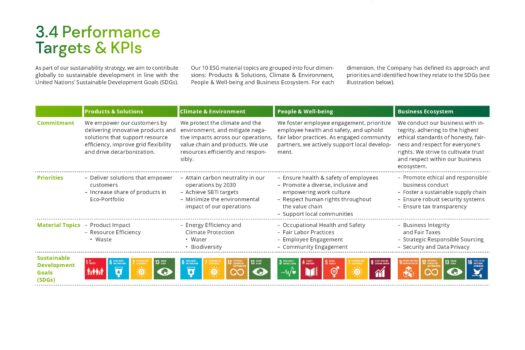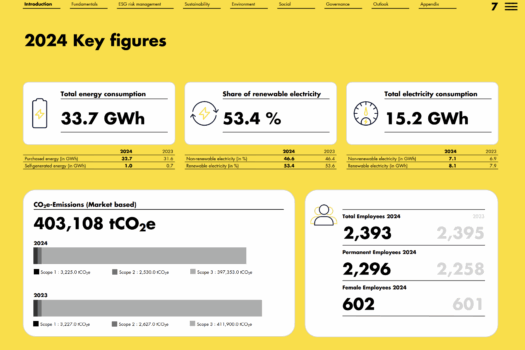An SBTi target provides decision-makers with certainty and clear guidelines for the implementation of effective climate protection. In the AMAG Group, it supports the corporate transformation with the strategic goal of developing decarbonized mobility solutions.
In 2024, the Science Based Targets Initiative (SBTi) exceeded the number of 10,000 companies that have committed to science-based climate targets. Pressure from investors, customers and NGOs in particular has led to an increase in the number of participants, with the result that SBTi is often perceived by exposed companies as a quasi-regulatory requirement. Contributing to this perception is the fact that SBTi has developed a complex set of rules on how science-based targets are to be developed and validated by SBTi. At its core, the approach is simple: the scientific community sets a global budget for greenhouse gas emissions. SBTi translates this into medium and long-term emission reductions for sectors and companies.
“The SBTi specifications force a company to tackle the main sources of emissions in the value chain.”
The complexity arises from the numerous application rules for emissions in the company’s own operations (Scope 1 and 2) and in the value chain (Scope 3). The Greenhouse Gas (GHG) Protocol, which is quite demanding, must be implemented as an accounting standard. However, anyone like AMAG who takes up the challenge will realize that the SBTi regulations a company to tackle the really “hot potatoes” when it comes to emissions and to develop climate targets with impact.
Climate strategy as a driver of new business models
As an owner-managed Swiss company with around 7,500 employees, the AMAG Group is a company with a long tradition. Founded in 1945, AMAG works closely Volkswagen AG as the official importer of the Volkswagen brands and has recently positioned itself as a provider of individual and sustainable mobility solutions. This has been achieved, among other things, by merging the energy and mobility sectors and the associated merger and further development of numerous services in the areas of solar energy, charging infrastructure, leasing, sharing, subscription, rent and retail. The transformation of the business model is closely linked to the goals of the sustainability strategy. The Executive Board’s decision to implement an ambitious climate strategy is motivated less by regulation than by business considerations. The strategic goal of developing decarbonized mobility solutions is the focal point and serves to secure the company’s sustainable future and competitiveness. A commitment to the Swiss net-zero target in 2050 is not enough for a credible leadership role; an ambitious climate target must already trigger significant and measurable effects in the value chain in the medium term.
Ambitious climate targets according to SBTi
The AMAG Group’s SBTi target was successfully validated in December 2024. It is a “near-term target” with the target year 2030, which refers to the base year 2019 and consists of two parts. During this period, AMAG must reduce absolute emissions in its own operations (Scope 1 and 2) by at least 50%. This requires comprehensive energy efficiency measures and the use of renewable energy sources. The greater challenge, however, lies in the goal of reducing – nota bene – absolute emissions from the use of vehicles sold (Scope 3, Category 11) by at least 50%. Controlling the reduction in the use phase is only possible by expanding electromobility. In addition to suitable vehicles, this also requires the promotion of charging infrastructure and the provision of sufficient renewable electricity. This is precisely where AMAG comes in and aims to make a contribution to reducing emissions from the mobility supply in Switzerland by expanding charging points in Switzerland, facilitating billing via the ChargeON charging card and expanding photovoltaics via Helion.
Translation work crucial for implementation
Successful implementation requires translation work within the organization and externally in the market. The basic prerequisite for this is that the management stands behind the objectives and actively supports and communicates the strategy.
The challenge within the organization is that the currency “CO2” is not very familiar in day-to-day business. By saying “yes” to SBTi, AMAG’s management has committed itself firstly to building up new specialist knowledge within the company. This specialist knowledge is initially distributed among a small number of people. Secondly, for the implementation to succeed, transfer work must be carried out across the board and across departments. It helps that the CO2-data located in the Finance department at AMAG. The aim is to establish CO2 as a second currency and to maintain the data with the same quality standards as the financial data. Finally, CO2-data must be made comprehensible and dependencies between CO2 and day-to-day business processes such as purchasing, business development or investments must be highlighted.
Climate targets according to SBTi are a complex process and require a methodical understanding of the requirements and the development of expertise at several levels. However, the added value outweighs this: SBTi protects against arbitrariness and focuses on the impact of the targets. This ensures credibility and creates clarity when implementing packages of measures.
This article was published in The Reporting Times by the Center of Corporate Reporting.
On June 18, 2025, the Sustainserv Best Practice Session on this topic will take place at the Reporting Symposium together with AMAG ‘From Compliance to Impact: Achieving Climate Goals through SBTi?‘.
Get in touch. We are happy to tell you more about it.





